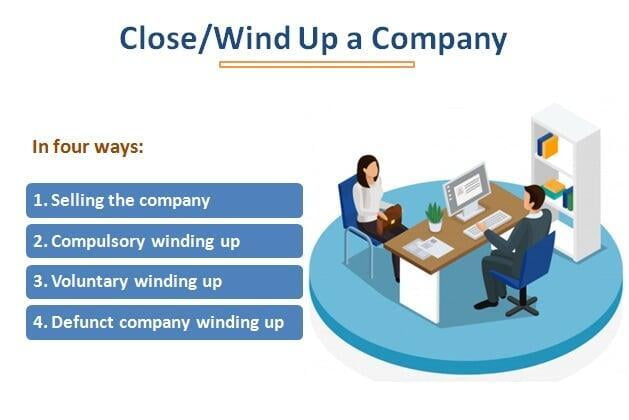Private Limited Company Closure/Strike Off/Winding Up

Running a business comes with its own challenges. Sometimes when things do not work out a business may have to be shut down. There can be several reasons to close or wind up the company. Here are four ways in which a private limited company can be closed. Now, you can close down the business very easily by removing the name of your company from MCA records. Our experts will help you get this done in no time. This is applicable if
- Your company has not commenced business within one year of incorporation; or
- Your company has not carried out any business or operation for preceding two financial years
Did not commence your business or no business at all now ? Get your company name removed from the MCA database with TAXAJ.
It usually takes 7 to 10 working days.
👉 Company Name removal from MCA database
👉 Conduct Board Meeting to pass special resolution to strike off the name of the Company
👉 Conduct Extraordinary General Meeting of the Shareholders to pass special resolution for name approval
👉 File MGT14 after EGM (with 30 days of passing of special resolution)
👉 Certify statement of accounts by CA (Statement should not be older than 30 days from the date of application)
👉 File e-form STK-2 along with prescribed attachments
👉 Public Notice issued by ROC for name removal
- Company with no operations
- Company without any third party transactions
- Company with no employees
- Company with no registration under GST, VAT and other tax departments
- Purchase of Plan
- Expert Assigned
- Preparation of name removal Documents
- Filing with ROC
Name, Contact Number and Email Id of all the Stakeholders.
Directors Identification Number, if already.
Self Attested PAN, Aadhar & Passport size photo of all the Stakeholders.
PAN, TAN, COI, Share Certificates of the Company.
NOC from commercial departments
Letter of account closure from bank
Previous Year's Audited Financials & Tax Reports
Complete Walk Through Process for easily Closing your Company!
How to Close Pvt Ltd Company?
There are 4 prevalent ways to wind up your private Limited company. In this article we will discuss all of the four ways of shutting down your business permanently. So, In this article we cover the following topics:

Sell the Company
To sell off a Private Limited Company is also a kind of voluntary winding up. You can sell the company by selling shares (selling the majority shareholding of the company). Technically speaking, it is not an actual winding up, but the stakes are transferred to another person or entity, and the majority shareholders are discharged of their stocks and responsibilities.
Compulsory Winding Up
Any company registered in India under the Companies Act, which did an unlawful act, fraudulent act or even if they contributed any action in some fraudulent or illegal activities then such company would be wound up compulsorily by the Tribunal. The procedure is explained below:
1.1 Petition will be filed
The petition will be filed by the following:
👉 The Company or
👉 The Trade Creditors of the Company or
👉 Any contributory or Contributors to the company or
👉 Any or all of the above mentioned three categories or
👉 The Central or State Government or
👉 By the Registrar of the Companies
👉 The petition should be in the Form WIN 1 or WIN 2 and should be submitted in triplicate. The petition shall be accompanied by an affidavit in Form WIN 3.
1.2. Advertisement for at least 14 days
The Petition should be Advertised in a daily journal at least for 14 days and the language of the advertisement should be in the Regional language (Regional Language of the area) and in English. The Advertisement must be carried out under Form 6.
1.3. Proceedings of the Tribunal
The Tribunal will hear the petition on the date fixed for hearing, accept objections and replies from the petitioner and respondent. The Tribunal may appoint a provisional liquidator. The order appointing provisional liquidator shall be made in Form WIN 8. The order of winding up shall be made in Form WIN 11. The order of winding up shall prescribe:
👉 The duty of such persons to submit the complete audited books of accounts up to the date of the order.
👉 Provide the date, time and place for the Company Liquidator
👉 Surrender the assets and the documents of the assets to the Company liquidator.
Upon a winding-up order, the Company liquidator shall take into custody all properties and effects, actionable claims and the books and papers of the company. The Company liquidator shall submit a report to the Tribunal within 60 days of the date of the winding-up order. After the affairs of the company have been completely wound up, the Company liquidator shall make an application to the Tribunal for dissolution of the company. If the tribunal finds it just and reasonable in the circumstances of the case that an order for the dissolution of the company should be made, make an order that the company be dissolved from the date of the order. The company shall be dissolved accordingly. The Company liquidator shall within 30 days of the date of the order, forward a copy of the order to the registrar.
If the tribunal finds the accounts are in order and all the required compliance have been satisfied, the tribunal would pass the order for dissolving the company within a period 60 days of receiving the application. After the order has been passed by the tribunal, the registrar will then issue a notice to the Official Gazette stating that such company is dissolved.
Voluntary Winding Up
Winding up a company voluntarily require long procedural compliance to follow. There are certain mandatory requirements which have to be completed to close down a company voluntarily. A company can be wound up voluntarily in the situations mentioned below:
– The company passes a resolution in its general meeting upon the expiry of the duration for which it is formed, or upon the occurrence of any event in respect of which the articles provide for its dissolution, or
– The company passes a special resolution (with approval of at least 3/4th of the shareholders) for a voluntary winding up of the company.
The voluntary winding-up commences from the date of passing of the resolutions mentioned above. The company should also appoint a Company liquidator in the same meeting. Such an appointment should also be confirmed by a majority of the creditors (in terms of value) of the company.
Procedure:-- Company passes a resolution in their general meeting as mentioned above. However, the majority directors must agree for winding up.
- The consent of the Trade Creditors is also required to wind up the company. Trade Creditors has to give their approval that they don’t have any obligation if the company gets wound up.
- The Company has to make a Declaration of Solvency and the same must be accepted by the trade creditors of the company. The Company must show the Company’s credibility in Declaration of Solvency.
- The liquidator so appointed will carry out the winding-up proceedings and prepare a report of the winding-up on the assets, properties, debts and so on. The report shall be laid before the general meeting of the company for approval, and passing a resolution for dissolution of the company. The Company liquidator shall send a copy of the final accounts of the company and resolutions to the ROC
- The Company liquidator shall also make an application to the Tribunal for an order of dissolution of the company. Upon being satisfied with the winding up, the Tribunal shall pass an order of dissolution within 60 days of the application. A copy of the final order should be filed with the ROC.
All the above-mentioned procedures shall be presented and filed in a prescribed form and even after the company gets wound up then also company’s name shall be prohibited for 2 years to be taken by any other applicant.
The format for various forms and detailed procedure for winding up is prescribed in Companies (Winding up) Rules, 2020.
Defunct Company Winding Up
As per the Companies Act, 2013, a Defunct Company is a company which has gained the status of a Dormant Company. The government provides certain relief to such defunct or dormant company because there are no financial transactions undertaken by dormant companies.
The Companies Act, 2013 laid down the procedure for winding up a Defunct Company. A Defunct or Dormant Company can be wind up with a fast-track procedure which requires submission of the STK-2 form. Hence, Form STK-2 is required in order to wind up a Defunct Company and there is no additional procedure for that. The form STK-2 needs to be filled with the Registrar of Companies and the same needs to be duly signed by the director of the company authorized by its board to do so.
For the purpose of this scheme, a defunct company refers to a company which has:
- No asset and no liability, and
- Which has not commenced any business activity after its incorporation or
- Has not been carrying on any business activities since last one year prior to making an application under FTE (Fast Track Exit Scheme).
Granting the “Dormant Status”
This option is suitable when you have registered a company for a future project and hence the company is not operational currently. Also, where an in-operational company cannot be closed as it might be holding assets such as land, building etc., choosing the “dormant status” is a good option.
Let’s understand what’s a Dormant company?
A dormant company is a company which is inactive i.e. a company which has the following characteristics:
- It has not been carrying on any business or operation
- It has not made any significant accounting transaction during the last two financial years.
- It has not filed financial statements and annual returns during the last two financial years.
- A defaulting Company which has not filed annual returns and financial statements for two years or more.
Procedure for obtaining status of dormant company:
- An application must be made in form MSC-1 to get the “Dormant” status.
- A special resolution should be passed to authorise the directors to make application for Dormant status. Thus, we need to file E-form MGT-14 with ROC for filing special resolution.
- The Registrar shall, after considering the application filed in Form MSC-1, issue a certificate in Form MSC-2 allowing the status of a Dormant Company.
Advantages of applying for ‘Dormant Status’
There is lesser compliance burden for a dormant company which reduces the costs of maintaining such a company.
‘Dormant Companies’ are exempted from the following compliances:
- To include cash flow statements in their financial statements.
- Reduced compliance for holding board meeting in each quarter. These companies are required to hold only two board meetings during the year.
- These companies do not require to rotate the auditors
Compliances to be met by a dormant company:
- It shall file a “Return of Dormant Company” each year, indicating financial position which should be audited by a chartered accountant in practice in
- Form MSC-3 along with such annual fee as provided in the Companies (Registration Offices and Fees) Rules, 2014 within a period of thirty days from the end of each financial year.
Also, note that maximum tenure for which a company can remain dormant is 5 consecutive financial years.
If a company remains dormant for more than 5 years, the Registrar commences the process of striking off the name of the company from the Records, i.e. the company will be removed.

